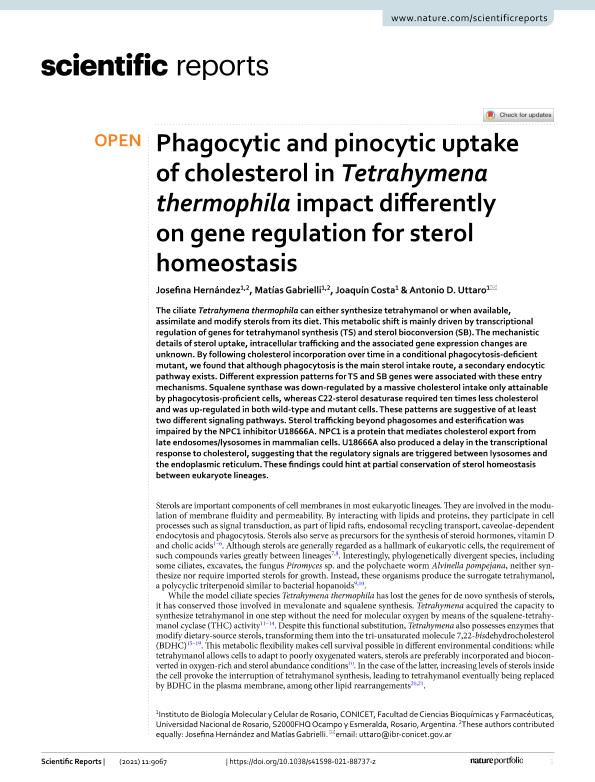Artículo
Phagocytic and pinocytic uptake of cholesterol in Tetrahymena thermophila impact differently on gene regulation for sterol homeostasis
Fecha de publicación:
04/2021
Editorial:
Nature
Revista:
scientif reports
ISSN:
2045-2322
Idioma:
Inglés
Tipo de recurso:
Artículo publicado
Clasificación temática:
Resumen
The ciliate Tetrahymena thermophila can either synthesize tetrahymanol or when available, assimilate and modify sterols from its diet. This metabolic shift is mainly driven by transcriptional regulation of genes for tetrahymanol synthesis (TS) and sterol bioconversion (SB). The mechanistic details of sterol uptake, intracellular trafficking and the associated gene expression changes are unknown. By following cholesterol incorporation over time in a conditional phagocytosis-deficient mutant, we found that although phagocytosis is the main sterol intake route, a secondary endocytic pathway exists. Different expression patterns for TS and SB genes were associated with these entry mechanisms. Squalene synthase was down-regulated by a massive cholesterol intake only attainable by phagocytosis-proficient cells, whereas C22-sterol desaturase required ten times less cholesterol and was up-regulated in both wild-type and mutant cells. These patterns are suggestive of at least two different signaling pathways. Sterol trafficking beyond phagosomes and esterification was impaired by the NPC1 inhibitor U18666A. NPC1 is a protein that mediates cholesterol export from late endosomes/lysosomes in mammalian cells. U18666A also produced a delay in the transcriptional response to cholesterol, suggesting that the regulatory signals are triggered between lysosomes and the endoplasmic reticulum. These findings could hint at partial conservation of sterol homeostasis between eukaryote lineages.
Palabras clave:
CILIATES
,
STEROLS
,
TRANSPORT
,
SIGNALING
Archivos asociados
Licencia
Identificadores
Colecciones
Articulos(IBR)
Articulos de INST.DE BIOLOGIA MOLECULAR Y CELULAR DE ROSARIO
Articulos de INST.DE BIOLOGIA MOLECULAR Y CELULAR DE ROSARIO
Citación
Hernandez, Josefina; Gabrielli, Matias; Costa, Joaquin; Uttaro, Antonio Domingo; Phagocytic and pinocytic uptake of cholesterol in Tetrahymena thermophila impact differently on gene regulation for sterol homeostasis; Nature; scientif reports; 11; 1; 4-2021; 1-11
Compartir
Altmétricas




